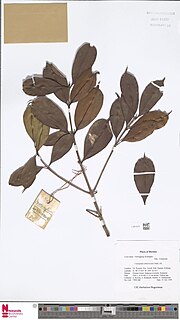
Cratoxylum arborescens is a plant in the family Hypericaceae. The specific epithet arborescens is from the Latin meaning "tree-like".

Cratoxylum maingayi is a plant in the family Hypericaceae. It is named for the botanist Alexander Carroll Maingay.
Alangium nobile is a tree in the dogwood family Cornaceae. The specific epithet nobile is from the Latin meaning "noble" or "distinguished", likely referring to the growth habit.
Anisophyllea beccariana is a tree of tropical Asia in the family Anisophylleaceae. It is named for the Italian botanist Odoardo Beccari.
Anisophyllea disticha is a plant of tropical Asia in the family Anisophylleaceae. The specific epithet disticha is from the Latin meaning "2-ranked", referring to the leaf arrangement.
Brackenridgea palustris is a tree in the family Ochnaceae. The specific epithet palustris is from the Latin meaning "swampy", referring to the species' habitat.
Canarium littorale is a tree found in tropical Asia and is a member of the incense tree family Burseraceae. The specific epithet littorale is from the Latin meaning "of the seashore", referring to its habitat.
Canarium patentinervium is a tree of tropical Asia in the incense tree family Burseraceae. The specific epithet patentinervium is from the Latin meaning "spreading nerves", referring to the leaf veins.
Euthemis minor is a plant in the family Ochnaceae. The specific epithet minor is from the Latin meaning "small", referring to the species' smaller size when compared with E. leucocarpa.
Radermachera ramiflora is a tree in the genus Radermachera of the family Bignoniaceae. The specific epithet ramiflora is from the Latin meaning "flowering on the branches".

Deplanchea is a genus of about eight species of tropical rainforest trees, constituting part of the plant family Bignoniaceae.
Dipterocarpus kunstleri grows as a canopy tree up to 40 metres (130 ft) tall, with a trunk diameter of up to 1 metre. Bark is orange-brown. Fruit is ellipsoid, up to 5 centimetres (2.0 in) long. Habitat is mixed dipterocarp forest from sea-level to 400 metres (1,300 ft) altitude. D. kunstleri is found in Sumatra, Peninsular Malaysia, Borneo and the Philippines.
Dipterocarpus rigidus grows as a large tree up to 50 metres (160 ft) tall, with a trunk diameter of up to 1 metre. Bark is rust-brown. The fruits are roundish, up to 5 cm (2 in) in diameter. Habitat is mixed dipterocarp forest on low hills near coasts. D. rigidus is found in Sumatra, Peninsular Malaysia and Borneo.
Dipterocarpus sublamellatus grows as a large tree up to 70 metres (230 ft) tall, with a trunk diameter of up to 3 metres (10 ft). Bark is orange-brown. The fruits are round, up to 3 cm (1 in) in diameter. It is found in a variety of now vulnerable habitats from sea-level to 400 metres (1,300 ft) altitude. D. sublamellatus is native to Sumatra, Peninsular Malaysia and Borneo.
Diospyros areolata is a tree in the family Ebenaceae. It grows up to 30 metres (100 ft) tall. Twigs are reddish brown when young. Inflorescences usually bear three flowers. The fruits are round, up to 4 cm (2 in) in diameter. The specific epithet areolata is from the Latin meaning "net-like", referring to the leaf veins. Habitat is lowland mixed dipterocarp and swamp forests. D. areolata is found in Peninsular Thailand, Sumatra, Peninsular Malaysia, Java and Borneo.
Diospyros subtruncata is a tree in the family Ebenaceae. It grows up to 22 metres (70 ft) tall. Inflorescences bear up to three flowers. The fruits are obovoid, up to 3 cm (1 in) long. The specific epithet subtruncata is from the Latin meaning "somewhat truncated", referring to the calyx. Habitat is lowland mixed dipterocarp forests from sea level to 400 metres (1,300 ft) altitude. D. subtruncata is found in Sumatra and Borneo.
Combretocarpus is a monotypic genus of tree in the Anisophylleaceae family. The generic name combretocarpus is from the Greek, referring to the resemblance of its fruit to that of the genus Combretum. As of April 2014 The Plant List recognises the single species Combretocarpus rotundatus.
Dacryodes laxa is a tree in the family Burseraceae. The specific epithet laxa is from the Latin meaning "loose", referring to the inflorescence.
Maclurodendron porteri is a tree in the family Rutaceae.
Lithocarpus bancanus is a tree in the beech family Fagaceae. The specific epithet bancanus is from the Latin, meaning "of Bangka".



